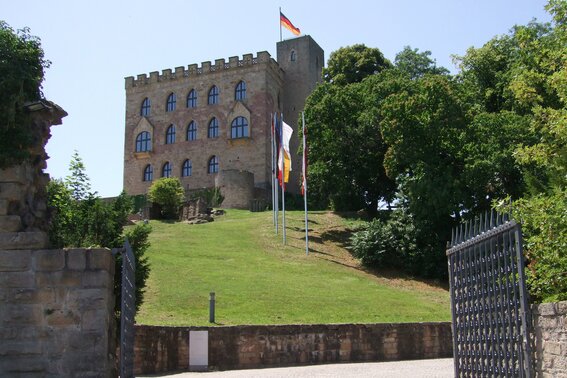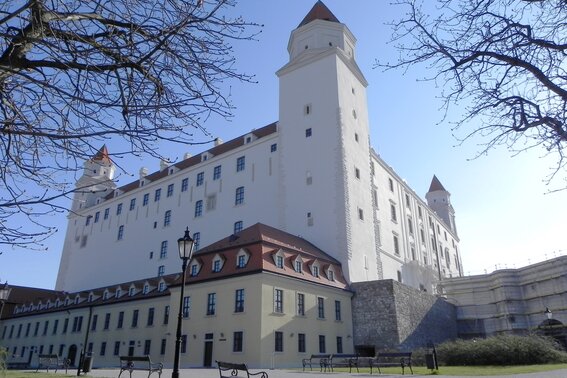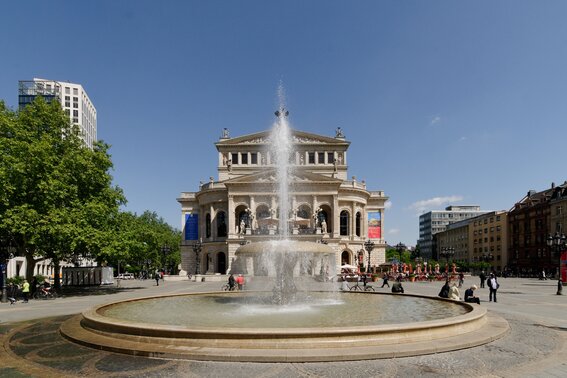Preservation of monuments with drainage: Gutjahr puts Karl Marx's head back onto dry feet
Wet feet for the most popular photographic subject in Chemnitz: a crumbling concrete base, damaged granite slabs - the 13 metre high Karl Marx monument was in urgent need of renovation after 40 years. But the stylish restoration of one of the largest portrait busts in the world made the highest demands of both the covering work and also the urgently required drainage of the structure. After successful renovation, the completely renovated monument is now attracting attention again - and finally has "dry feet".
The base of the monument, which was erected in 1971, was about 18.5 by 10.5 meters wide and 60 centimetres high, with a concrete and brick core. Granite slabs from the Ukraine had been laid in a bed of mortar on the surface. But the water that constantly penetrated through the joints accumulated in the mortar. Over the course of time, this accumulation of moisture led to damage to the covering and the concrete, resulting in cracks, broken areas and loose slabs. In short: The photographic subject that was so popular with visitors to Chemnitz had become unsightly.
The urgently needed renovation work started at the end of 2011. The client decided to install waterproofing as well as the concrete renovation work that was required. The covering was to be laid in the gravel bed on an anti-capillary surface drainage mat. A particular challenge: the original visual appearance and the overall appearance were to be retained as far as possible.
On the track of the original stone
For this reason, the slabs that were still were put back in place. A good 75% of the old material could still be used. For this purpose, the approximately 250 existing slabs were carefully picked up, checked for damage and cleaned. But where do you find similar replacement slabs that fit seamlessly into the existing picture after so many years? Stone needed to be found that matched the existing material exactly in terms of texture and colour. This actually succeeded: after intensive research, the quarry that had supplied the original slabs four decades earlier was located in the Ukraine. Some of the Ukrainian workers even remembered what happened at the time. Result: It was possible to deliver the new stone with the same structure, making them indistinguishable from the original.
Top marks for AquaDrain T+
The tBU Greven has extensively tested AquaDrain T +. The result: In comparison to the most popular drainage mats for balconies and terraces, this system has the best drainage values – thanks to having a drainable cavity of 95%.
Dry feet thanks to drainage
In contrast to the previous version, it was decided to lay the covering loosely in the bed of gravel. In order for the expensively obtained Ukrainian granite to remain beautiful, permanent drainage of the structure had to be ensured. However, layers of gravel and chippings alone are not anti-capillary, which was confirmed by an investigation by the MPA Wiesbaden. If there is water on the waterproofing, such as at the overlap of membrane joints, it is transported back to the surface via the bed of gravel or chippings. This can easily result in moisture stains on the high-quality natural stone coverings, or the pressure of ice will cause unevenness. Weed growth on loose coverings is also speeded up by permanently moist bedding layers.
Master roofer Frank Friedrich from Chemnitz, who carried out the waterproofing work on the base of the bust, had already made good experiences with Gutjahr's AquaDrain T + surface drainage system in the past, which is why the company used it here as well. The advantage thereof: The mat is anti-capillary and drains the water from the layer or chippings, even if there is water on the waterproofing in some places.
Well thought-out system
AquaDrain T + consists of a plastic film with a laminated special fleece which creates an anti- capillary air layer. This prevents backwater on the waterproofing from migrating back via the layer of gravel or chippings into the coverings and causing damage. Due having a drainable cavity of 95%, the Gutjahr system achieved the best drainage values in a test by the tBU Greven in comparison with all of the most popular drainage mats.
The large contact area of 66% also avoids high point loads, meaning that an additional protective layer on the waterproofing is therefore not required.
Well thought out: The entire drainage system
For the plinth, master roofer Frank Friedrich unrolled the 16 mm high version of the drainage mat onto the substrate that he had sealed – a total of about 120 square meters. A 50-75 mm thick layer of chippings (grain size 4-8 mm) was then laid on top. Natur- und Kunststeinbau Herberholz then installed the 110 x 54 x 3 cm granite slabs with 8 mm wide joints to speed up the drainage of the surface. The seepage water is then directed to the edge of the base on the waterproofing, where it can flow into a gravel bed in the approx. 2 cm thick cavity between the concrete base and the vertical slabs.
The Karl Marx head is now resting on a solid foundation again. And that's a good thing: the memorial is an integral part of the Chemnitz cityscape. And now it is also a manifesto for the successful combination of material and technology and the cooperation across trades and national borders.
About the Karl-Marx monument
Soviet sculptor Lew Kerbel (1917-2003) designed the huge portrait bust of Karl Marx. The Karl Marx head, nicknamed "Nischel" by the people of Chemnitz, was erected in 1971. With a face height of 7.10 meters and weighing about 40 tons, the bronze monument is one of the world's biggest largest portrait busts.
Products used
Similar project reports



![[TRL] Gutjahr Systemtechnik GmbH - Komplettsysteme für den Außen- und Innenbereich](/build/images/gutjahr-logo.d62773db.svg)






